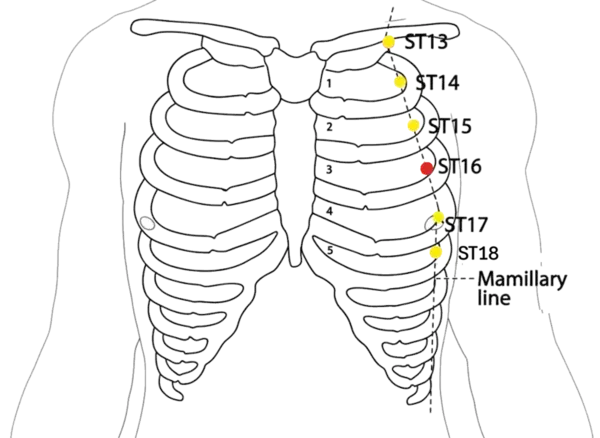ST-16 - Breast Window
膺窗 - Yīng chuāng
Point Region: Chest
ST-16 Yingchuang, meaning 'Breast Window,' is a point that clears phlegm and regulates the chest. Located on the chest, it is a key point for addressing a wide range of issues that are caused by 'phlegm' or stagnation in the upper body. Its name, 'Breast Window,' alludes to its ability to bring a sense of order and harmony to the body's entire system.
Think of Yingchuang as a point that helps to 'open the window' to your chest. It's invaluable for addressing issues like a cough with phlegm, a feeling of heaviness or a thick chest, and a restless spirit. By clearing phlegm and regulating the chest, it helps to restore a sense of ease and freedom.
By clearing phlegm and regulating the chest, ST-16 helps to restore a sense of balance and inner peace. It's a point that reminds us that our true power comes from a clear and unburdened body.
Location & How to Find
Anatomical Location: On the chest, in the fourth intercostal space, 4 cun lateral to the anterior midline, level with CV-17 and the nipple line.
How to Locate:
- Find your collar bone and feel for the ribs below it
- Count down to find the fourth space between your ribs
- This is typically at the level of your nipple
- The point is in this fourth intercostal space

Primary Functions
Respiratory System
- Treats cough and bronchial disorders
- Relieves chest congestion and tightness
- Improves breathing and lung function
- Reduces respiratory inflammation
Lactation Support
- Promotes healthy milk production
- Treats lactation difficulties
- Relieves breast tenderness and swelling
Digestive System
- Harmonizes stomach qi in chest area
- Treats heartburn and acid reflux
Musculoskeletal System
- Relieves chest muscle tension
- Treats intercostal pain and discomfort
Clinical Applications
Primary Indications
- Chest tightness
- Shortness of breath
- Intercostal discomfort
- Chest pain
- Breathing difficulty
- Rib pain
- Respiratory problems
Related Health Concerns
Common Conditions:
Related Acupoints
Select a point to learn about its location, primary functions, clinical applications, and protocols.
ST-16 Protocols
N/A
Important Precautions
- Recent chest surgery
- Severe respiratory conditions
- Chest wall injuries
- Breast implants